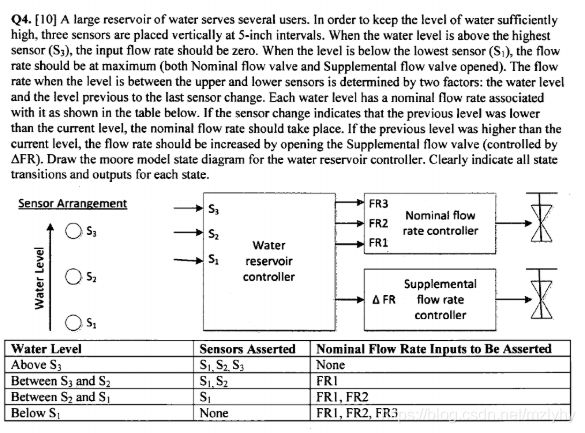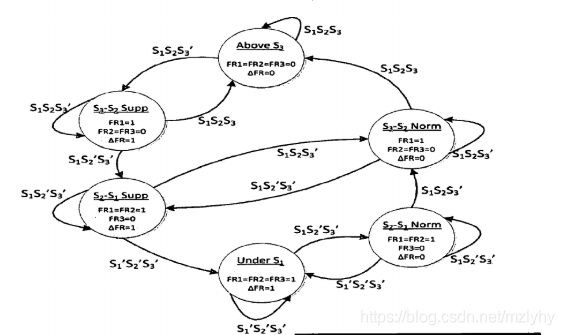HDLbits Exams/ece241 2013 q4
HDLbits Question 123
Exams/ece241 2013 q4

I reckon most of guys could read through instructions over that question so that I won’t do any explanations further (smile).
While I was trying to figure that question, I realized few points you might need to take care as well: each state of ‘s’ has either 1 or 0 status when flow rate would be as either nominal or supplemental scenarios, the total FSM is being either increasing water level or decreasing the water level.
I saw there ain’t so much of pictures drawing the FSM, but a interesting thing is that quastion was from my college’s exam. I’m sharing a right FSM picture drawn by examiner.

This is pretty clear figure that explains how water sensors work in this case. Thus, I’m just going to put my own source code that might be written as a typical way including synchronous transition logic and state changing logic.
// top_module define
module top_module (
input clk,
input reset,
input [3:1] s,
output fr3,
output fr2,
output fr1,
output dfr
);
//rename/define parameters in the case
reg [3:0]state, next_state;
reg [3:0] uns1, s2s1norm, s3s2norm, aboves3, s3s2supp, s2s1supp;
//assign state values to each state name
//fr3 fr2 fr1 dfr
assign uns1 = {1'b1,1'b1,1'b1,1'b1};
assign s2s1norm = {1'b0,1'b1,1'b1,1'b0};
assign s3s2norm = {1'b0,1'b0,1'b1,1'b0};
assign aboves3 = {1'b0,1'b0,1'b0,1'b0};
assign s3s2supp = {1'b0,1'b0,1'b1,1'b1};
assign s2s1supp = {1'b0,1'b1,1'b1,1'b1};
//fsm transition logic
always@(*)begin
case(state)
uns1:
if(s[1]&!s[2]&!s[3])begin
next_state = s2s1norm;
end
else next_state = uns1;
s2s1norm:
if(s[1]&s[2]&!s[3])begin
next_state = s3s2norm;end
else if(s[1]&!s[2]&!s[3])begin
next_state = s2s1norm; end
else next_state = uns1;
s3s2norm:
if(s[1]&s[2]&s[3])begin
next_state = aboves3;end
else if(s[1]&!s[2]&!s[3])begin
next_state = s2s1supp;end
else next_state = s3s2norm;
aboves3:
if(s[1]&s[2]&!s[3])begin
next_state = s3s2supp;end
else next_state = aboves3;
s3s2supp:
if(s[1]&s[2]&s[3])begin
next_state = aboves3; end
else if(s[1]&!s[2]&!s[3])begin
next_state = s2s1supp; end
else next_state = s3s2supp;
s2s1supp:
if(s[1]&s[2]&!s[3])begin
next_state = s3s2norm;end
else if(!s[1]&!s[2]&!s[3])begin
next_state = uns1;end
else next_state = s2s1supp;
endcase
end
//synchronous logic
always@(posedge clk)begin
if(reset)
begin
state <= uns1;
end
else
begin
state <= next_state;
end
end
assign {fr3,fr2,fr1,dfr} = state;
endmodule